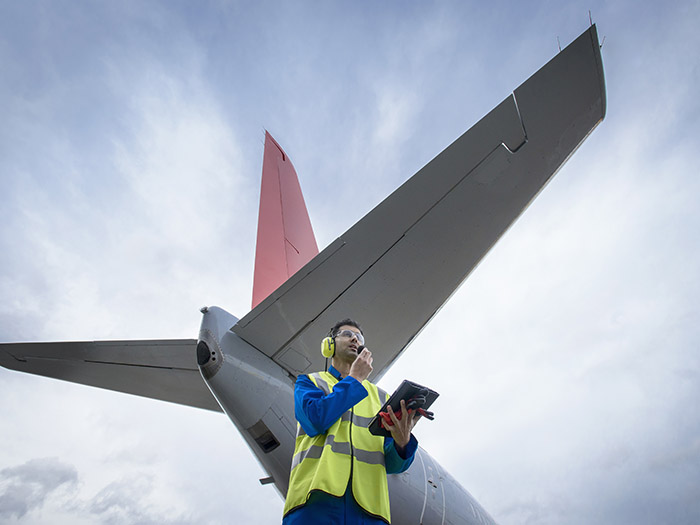How AXA XL Is Approaching Insurance Talent Recruitment and ...
While current flight and maintenance crew talent shortages are impacting aviation operations, the industry is still one of the most heavily regulated. Partnering with an insurer that understands the sector’s strengths and weaknesses can add tremendous value when managing risk.

U.S. airlines transported an estimated 658 million passengers in 2021, according to the Bureau of Transportation Statistics. That number increased 30% year-over-year in 2022 as an estimated 853 million passengers soared through the bright blue skies.
Experts believe those numbers will only continue to climb post-pandemic, which is why reviewing and bolstering aviation safety practices is more important than ever.
“Keeping the skies safe is paramount,” said Peter Pogue, vice president, head of aviation claims, QBE North America.
“That starts with knowing the risks and actively addressing them. Another important factor in aviation safety is partnering with a knowledgeable insurer to effectively handle claims and identify and mitigate risks,” Pogue said.
While losses in aviation are infrequent compared to other forms of transport, when a crisis does occur, the severity of the loss and the negative publicity it attracts can be extremely damaging to a company’s business and reputation. One effective way to avoid losses of any kind is implementing safety best practices, which can be augmented depending on which insurance partner an aviation company works with.
Here’s a more in-depth look at recent risks impacting aviation, how to avoid loss through safety best practices and what a strong insurance partner looks like.
Reviewing the Risks to Passenger and Crew SafetyPeter Pogue, Vice President, Head of Aviation Claims, QBE North America

When it comes to managing the most current and pressing risks within aviation, the impact of the COVID-19 pandemic — and the importance of experienced talent across all segments of the industry — cannot be underestimated.
A tenured, experienced crew goes a long way toward maintaining and improving safety, but the current aviation workforce is experiencing a shift.
“With the pandemic came a reduction in overall flight activity, and many pilots took time to reevaluate their work-life balance. As a result, the supply of pilots was challenged by a wave of early retirements and a difficult value proposition for potential candidates,” said Lamont Rosemond, vice president of technical underwriting and head of general aviation, QBE North America.
While it was widely known that a talent shortage due to an aging workforce was on the horizon, the aviation industry wasn’t prepared for the accelerated nature of the pilot exodus caused by the pandemic, or the extent to which it impacted succession planning. It’s a predicament several industries are facing post-pandemic, Rosemond added, but for aviation it means a shortage of experienced pilots to meet the increased hiring demand as air travel returns to (and in some cases exceeds) pre‑pandemic levels.
This talent shortage spans multiple segments of the aviation industry. Without adequate staffing within air traffic control towers, as another example, there’s a potential risk of an uptick in runway incursions involving sitting aircraft or aircraft departing at the last second.

Lamont Rosemond, Vice President of Technical Underwriting and Head of General Aviation, QBE North America
It’s a problem that’s also being discussed on the maintenance side of aviation: “Within large aviation MRO (maintenance, repair and overhead), the turnover in experienced staff is concerning,” said Gregg Strange, head of major risks, aviation, QBE North America. “Maintenance facilities are having a very tough time attracting and retaining talent.”
A shortage of maintenance workers can lead to flight delays or even faulty aircraft. This can impact not only safety but profitability, disrupting schedules and potentially leading to an increase in the number of disgruntled passengers, which produces another risk area all its own.
“During COVID, we noticed a significant uptick in passenger disruption on flights,” Strange said. At the height of the pandemic, tension naturally rose due to the stress and fear of the virus. As time has passed and COVID has become more manageable, there’s been a slight decrease in passenger disruption. However, it isn’t eradicated, the QBE team said.
With this risk, the most important thing to consider is flight crew safety and training. “How do they handle those situations? Are they well equipped to deescalate a situation safely? Training and education are key,” said Strange.
Aviation Best PracticesGregg Strange, Head of Major Risks, Aviation, QBE North America
While risks will always exist, aviation remains a highly regulated industry. When it comes to reporting incidents, there are several channels in place to act as safeguards.

“If you look at how big the industry is and how many aircraft are in the sky, even right now, there are few true catastrophic incidents reported on a regular basis,” said Strange. He noted that this is because the airline industry itself must operate at a higher standard. There’s a level of oversight and attention at every step of getting a plane off the ground at point A and landing it safely at point B.
“The amount of self-reporting that happens in the airline industry — whether from air traffic controllers, flight crew or administrative personnel — is abundant,” Strange continued. “There aren’t many mistakes that go unnoticed, and quite frankly, when they are brought up, the root cause analysis is a pretty extensive process between both the insurance carrier and the FAA.”
All of which is to reiterate that “aviation is a highly regulated and protected industry,” Strange said. “Even better, there are many best practices and guidelines in place that will continue to make it that much safer.”
Not only is the aviation industry continuing to comply with a wide range of standards and regulations to ensure the safety of passengers and crew, but it’s also creating strategic solutions to help overcome the talent crisis. Rosemond said airlines have done a respectable job establishing feeder programs, which entice more pilots into the profession and create a talent pool to help fill their pipelines for the future.
“In anticipation of the talent shortage, many airlines were proactive in establishing feeder programs, where they’ve been able to create pipelines and groom talent for success in their respective cultures,” Rosemond said. Another factor in attracting and retaining good talent comes down to compensation and benefits. General aviation operators, many of whom have lost top talent to the airlines, have tried offering better compensation and benefits, as well as more reasonable schedules, to combat the trend. “However, it’s been a challenge, as airlines can offer far more stability in pilot schedules, as well as more competitive salaries and signing bonuses.”

Both Rosemond and Strange noted that feeder programs, while successful, aren’t a one-size-fits-all solution to talent management across every division of aviation, so it may not be as impactful for part 91 or part 135 operators who have unique missions that require a specific skill set. But those operators are also making headway to establish their pipelines for the future.
It’s also advisable to start developing a robust strategy for succession planning as older, more experienced captains retire.
Training air traffic controllers is another best practice. Strange said that there are certified training programs offered by universities to help educate soon-to-be air traffic controllers, as well as FAA training programs, which create a pipeline of preparedness.
Partnering with an Insurer Who Gets ItHaving the deep knowledge and expertise to assess and manage the risks associated with the aviation industry is just the start of strengthening safety efforts. Collaboration among the risk management team is equally vital. To address aviation’s biggest risks and implement safety best practices, it’s important to partner with an insurer who not only understands the unique needs of aviation customers but also values a strong partnership between underwriting and claims.
“No one has all the answers,” Rosemond added. “But collaboration is key. Our underwriting and claims teams leverage their collective backgrounds and expertise to share best practices. From there, we can inform our insureds and trading partners on what’s happening in aviation, what’s working and how they can improve their overall operations.”

In today’s uncertain and challenging market, QBE North America recognizes the importance of having strong technical capabilities and using an innovative approach when assessing risk. Moreover, aviation customers are at the center of what the team does, and therefore managing risk remains a top priority for its underwriters and claims experts alike.
And if an incident should occur, “our aviation specialists communicate with the NTSB (National Transportation Safety Board) and the FAA,” Pogue said. “We work to quickly address claims, retrieve aircraft and investigate thoroughly to understand the incident and pay claims.
“It’s all to be able to speak knowledgeably with our underwriters, trading partners and insureds about the claim so that everyone understands what happened and what is covered by the policy,” he added.
This speed in identification and rigorous post-accident breakdown are what make QBE a great partner in addressing aviation risk. There is no gray area, as communication is comprehensive and transparent throughout the claims process. The claims team also has legal experience on its side, which is beneficial to clients should an incident land in today’s heightened litigious environment.
To learn more, visit: https://www.qbe.com/us/aviation.
This article was produced by the R&I Brand Studio, a unit of the advertising department of Risk & Insurance, in collaboration with QBE North America. The editorial staff of Risk & Insurance had no role in its preparation.
QBE North America is a global insurance leader focused on helping customers solve unique risks, so they can focus on their future. QBE operates out of 27 countries around the globe, with a presence in every key insurance market. QBE insurance companies are rated "A" (Excellent) by A.M. Best and "A+" by Standard & Poor's.















































